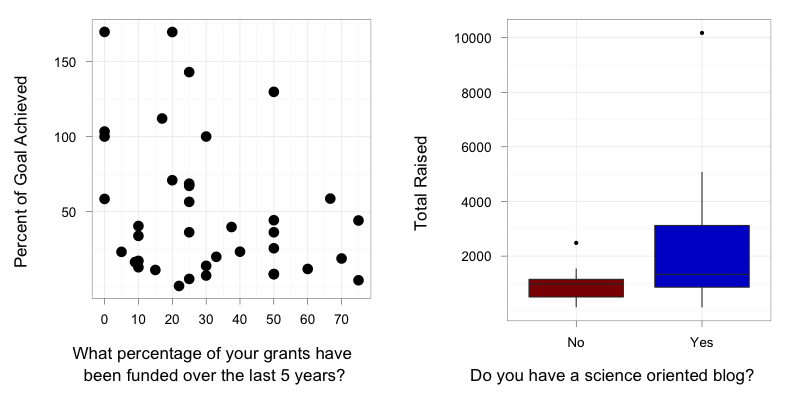#SciFund infographics
University objections to #SciFund – how do you counter them?

The vast majority of scientists participating in the #SciFund Challenge are based at universities (and by the way scientists, sign up here for #SciFund). And for lots of reasons, the #SciFund money raised by those university-based scientists will likely need to be routed through their universities.
To avoid a million headaches, it is really important for #SciFund scientists to clear their crowdfunding campaigns with their local grants administrators before projects launch in May. As crowdfunding for science is so new, many university administrators will be totally unfamiliar with it and might well raise a host of objections.
Success is more than money alone
Note from Jai. This post is by Kalani Kirk Hausman, one of the participants in the first round of the #SciFund Challenge. You can see his #SciFund project here and you can find him on Twitter at @KKHausman.

While chasing crowd-funding support for the STEMulate Learning program during the initial #SciFund Challenge, I did not reach an ambitious funding goal for a full high-performance computing lab. At first read, this sounds like failure – but was not.
Follow the money – what are the contribution patterns in science crowdfunding?
The second round of the #SciFund Challenge is open for business – sign up here!
So, Jarrett and I have been analyzing the data from the first round of #SciFund to determine the money patterns in science crowdfunding (check out Jarrett’s earlier posts here and here). This time, let’s drill down a bit to see what we can learn about those who contributed to #SciFund projects.
1 Click = 1 Dollar? Project page views and money raised
Adding a (mild) review process to SciFund – why the change?
If you haven’t heard, the second round of the #SciFund Challenge just kicked off. If you are a scientist and are interesting in engaging the public with your science and raising money for your research along the way, you can sign up here.

Okay, on to the topic of this post. One of the changes for the second round of #SciFund is that we are adding a very mild review process for scientists that want to participate. What is this review process about? And why are we making this change in the first place? After all, isn’t crowdfunding all about the wisdom of crowds?
What’s the review about?
This new #SciFund review process is not the formal peer review process that scientists go through to get manuscripts published in scientific journals. I certainly don’t knock traditional peer review, as the process leads to much better science.
Does Going Big Mean Going Home? Target Goal and Funding Success in #SciFund
Crowdsourcing Hypotheses: The #SciFund Data Challenge!
Welcome back, all. It’s been a few months, and I hope everyone has been enjoying the great science updates from a variety of projects and is still basking in #SciFund’s warm glowing warming glow. We’re even starting to gear up for #SciFund 2, Electric Boogaloo, so keep your eyes peeled.
But before we jump into round 2, Jai and I wanted to know more about round 1. What made for a successful project? How does a crowdfunded proposal compare to a non-crowdfunded grant proposal? What do you need to do to make #SciFund work for you?
To get at these questions and more, we administered a survey to the participants of #SciFund, and we’re starting to analyze it. We have a lot of ideas about relationships and hypotheses to test, but, in the spirit of crowdsourcing, we wanted to crowdsource some of this part of the project to you – the hypothesis generation. I’d say we’d open up the data, but, sadly, cannot due to Human Subjects requirements (see end of this post for an explanation).

So, below the cut is the survey we administered as well as the data fields from Dr. Zen’s excellent efforts. Take a look at it, and post any hypotheses or analyses you want to see done! Feel free to get as fancy, detailed, or nutty as possible, bearing in mind that we have 48 data points, and some of the data are continuous and some categorical.


